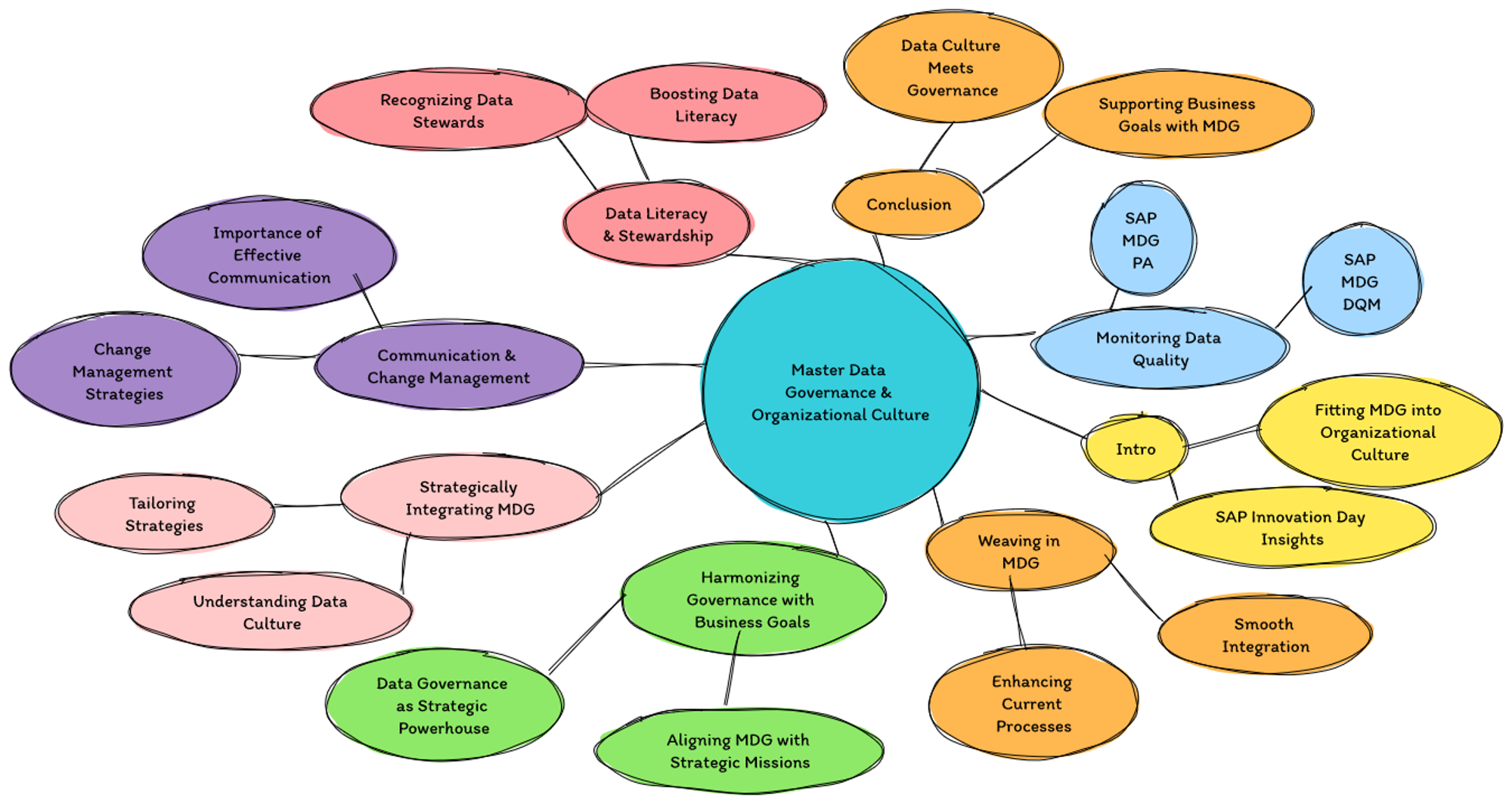
Intro
Last week in our SAP Innovation Day presentation, one of the topics we talked about together with our customer Heraeus was how implementing SAP Master Data Governance (MDG) isn't just about rules and technologies — a good MDG implementation is about fitting data governance smoothly into your organization's unique culture. Imagine it as seamlessly adding a new layer on top of the good work your team already does, making data management more effective and natural. This journey starts by really understanding how data is currently handled in your organization, and identifying what works and where improvements are needed.
The goal of Alluvion and Heraeus? To introduce MDG in a way that feels like a natural progression, enhancing current processes without causing disruption. Effective communication and a clear understanding of your organization's data culture are key to making this transition as smooth as possible. Let's dive into this journey where integrating MDG into your organization improves data practices while still aligning with your business goals, and creating a harmonious and efficient data governance environment just like Heraeus did!
Strategically Integrating MDG in the Organizational Culture
Integrating a Master Data Governance implementation into your organization's culture is a strategic move, but also needs to feel natural, almost like it has always been part of the rhythm. It's about enhancing what is already there, making sure every role and responsibility within your data ecosystem plays in harmony. The goal? To make managing your master data not only more effective but also a bit more harmonious. Let's explore how MDG can tune into your organization's unique rhythm, bringing out the best in your data practices with a style that's all its own.
First, Get a Grasp of your Organization's Existing Data Strategy
Understanding your company's data culture is really about getting down to the nitty-gritty of how everyone sees, uses, and takes care of data. You need to check what is working well and what is not. You've got to figure out where your organization stands in terms of data quality, how good your team’s data knowledge is, and how well they're handling the current processes. This step should help us spot the natural data roles, people have fallen into, inside your organization and the cracks where things are slipping through.
Next up, companies should dive deeper into their day-to-day operations. You're looking at how your team makes decisions with data and how they interact with it on the regular. This isn't just about dry stats and policies; it's about understanding the real-world flow of master data in your office. You're trying to get a clear picture of the unspoken rules and habits that are guiding the way master data is handled in the organization. With these insights, we can help you tailor your strategies to really click with your team, aiming to weave a stronger, data-focused mindset into your workplace.
Weaving in Master Data Governance Strategically
Once we have a solid idea of how data lives and breathes in your organization, rolling out MDG can be done with a bit more finesse. The beauty of this way of working is that MDG will not barge in and overturn everything; instead, it builds on what you're already doing. It's about giving a formal nod to the data tasks and roles that have naturally emerged and weaving data governance processes into your daily operations as smoothly as possible.
Putting MDG into play means taking a good look at how it fits with the specific ways your team works with data. It's not about slapping a one-size-fits-all plan on everything. Instead, you'll need to map out a strategy that threads MDG's principles through your existing data practices. The goal here is to fold governance into the current workflow in a way that feels natural, dodging major disruptions and making it easier for everyone to get on board with these new practices.
Introducing Change Through Communication
At the heart of rolling out MDG is a savvy change management game plan that really gets your organization's culture. When you start talking about MDG, it is crucial to communicate regularly about all the steps in the roll-out. We help you spell out why master data governance matters in the grand scheme of things and how it slots into the bigger picture of your company's ambitions, business processes, and long-term data quality. The key here is to assure everyone that MDG is here to make things better - think about improved data quality and ticking the right compliance boxes - without turning the daily work life of your business upside down.
However, it's not just about dropping a memo and calling it a day. Real change management means keeping the lines of communication wide open, offering clear updates on how the governance journey is unfolding, and showing how each person's efforts feed into a larger, shared vision. It's about starting conversations that build bridges between the MDG implementation specialists and everyone else, making sure you're all moving together in sync towards a more streamlined and effective data management setup.
The journey doesn't stop at just setting up rules and frameworks; the next step should be about nurturing a strong culture of master data, and data literacy in general. This step is all about spotting the data stewards and making sure they're officially recognized and equipped with the tools and know-how they need. This effort should not stop with the stewards, ramping up data literacy is a company-wide mission. It's crucial that everyone involved in the process gets the picture – understanding their bit in the whole data lifecycle and why keeping data clean and accurate matters.
Boosting master data knowledge is about continuous learning and support. Think of it as setting up a system where employees feel empowered and motivated to dive into data governance, armed with ongoing education and a supportive backdrop.
Creating Feedback Loops Through Monitoring Data Quality
This means that our master data stewards and process owners should receive a platform to shine and continuously improve the data governance processes and master data quality. Continually monitoring the data quality of your materials or business partners on SAP MDG Data Quality Management (DQM) allows for “smart” data management. It's about creating a vibe where users continuously reiterate and improve on data governance processes.
Is everyone playing their role correctly in steering the data ship safely? And are there any hiccups we might need to improve? Monitoring the duration of each step in our workflow through SAP MDG Process Analytics (PA) and tracking our data quality with DQM should provide an answer to where we can improve and iterate.
Harmonizing Data Governance with Business Aspirations
Integrating Master Data Governance with your organization's broader ambitions is where the magic really happens. It's about seeing MDG not as some standalone project or a tick-box compliance chore but as a core ingredient in your recipe for business success. The trick is to integrate data governance objectives tightly within your business outcomes. This means that every move in your MDG playbook should make a play for the bigger picture, pushing you closer to those key business targets. Think of the example of automating the creation of new customers while still following the data quality rules. This all should result in the possibility of giving these customers a quote of your offering as soon as possible.
What is crucial here is to ensure data governance doesn't get pigeonholed as just another task for the IT department. Instead, it is a cornerstone solution for the whole business, a lever you can pull to drive real value and sharpen your organization's edge in the market. By aligning governance efforts with your strategic missions, you turn data from “just another asset” into a strategic powerhouse, translating all that data diligence into tangible business wins and a stronger position in the competitive landscape.
Bringing It All Together: Data Culture Meets Governance
The connection between an organization's data culture and a successful rollout of the Master Data Governance can be complex. Alluvion can help you out with a strategic and measured approach in which it is crucial to not only acknowledge but also build upon the data culture that is already in place. By framing Master Data Governance as a key to unlocking better business performance, organizations can craft an MDG implementation that fits well with their culture and objectives.
This article has aimed to provide a view on how introducing SAP Master Data Governance inside the organizational culture should give an easier roadmap for companies eager to achieve their data governance goals in a way that is smooth and aligned with their strategic business aims.
By respecting the existing data culture and positioning data governance as a vital tool for enhancing business outcomes, it becomes possible to implement a data governance strategy that is both effective and culturally attuned. Here is to achieve your data governance ambitions in a manner that is straightforward, strategic, and supportive of your broader business goals. And Alluvion can help with that!
Thanks for reading this article and if you want more information don’t hesitate to reach out to Wouter Van Peteghem or Nicholas Vermeersch on LinkedIn. Or fill in the contact form on our website and we’ll get back to you ASAP.

Jo Buyl
Senior SAP Master Data Expert
Jo is an experienced expert in data governance, (master) data management, and data quality and a trusted advisor with a focus on project management and business requirements gathering.
Featured articles






